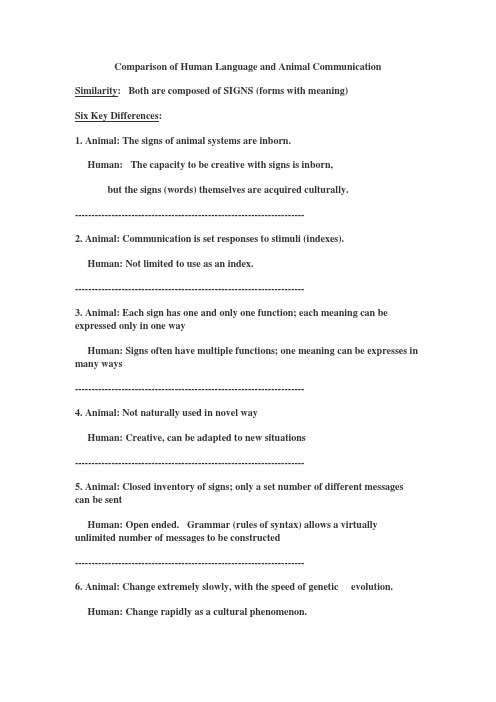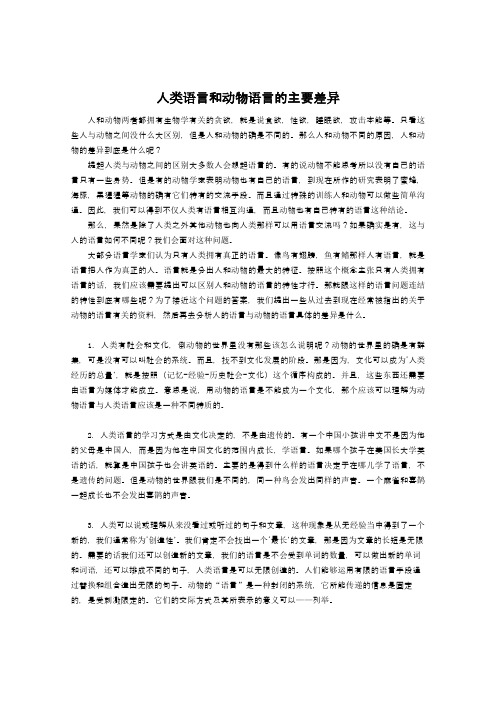人类语言和动物语言区别培训讲学
- 格式:ppt
- 大小:296.00 KB
- 文档页数:11


Comparison of Human Language and Animal Communication Similarity: Both are composed of SIGNS (forms with meaning)Six Key Differences:1. Animal: The signs of animal systems are inborn.Human: The capacity to be creative with signs is inborn,but the signs (words) themselves are acquired culturally.---------------------------------------------------------------------2. Animal: Communication is set responses to stimuli (indexes).Human: Not limited to use as an index.---------------------------------------------------------------------3. Animal: Each sign has one and only one function; each meaning can be expressed only in one wayHuman: Signs often have multiple functions; one meaning can be expresses in many ways---------------------------------------------------------------------4. Animal: Not naturally used in novel wayHuman: Creative, can be adapted to new situations---------------------------------------------------------------------5. Animal: Closed inventory of signs; only a set number of different messages can be sentHuman: Open ended. Grammar (rules of syntax) allows a virtually unlimited number of messages to be constructed---------------------------------------------------------------------6. Animal: Change extremely slowly, with the speed of genetic evolution.Human: Change rapidly as a cultural phenomenon.Swahili (adapted from An Introduction to Language, Fromkin and Rodman)One of the characteristic features of Swahili (and Bantu languages in general) is the existence of noun classes. There are specific singular and plural prefixes that occur with the nouns of each class. These prefixes are also used for purposes of agreement between the subject-noun and the verb. In the sentences given, two of these classes are included (there are many more in the language).A. Identify all the morphemes you can detect. Be sure to look for the other nounand verb affixes, including tense markers.Class 1 singular noun prefix m- Class 1 singular subject agreement a- Class 1 plural noun prefix wa- Class 1 plural subject agreement wa-Class 2 singular noun prefix ki- Class 2 singular subject agreement ki- Class 2 plural noun prefix vi- Class 2 plural subject agreement vi-present prefect prefix me-present progressive na-NounsClass 1 Class 2-toto child -su knife-tu man -kapu basketVerbs-fika ‘arrive’ -lala ‘sleep’ -anguka fallB. How is the verb constructed? That is, what kinds of morphemes are strung together and in what order? Agreement Prefix + Tense/Aspect Prefix + V6.) Examine the following words from Michoacan Aztecnokali “my house” mopelo “your dog”nokalimes “my houses” mopelomes “your dogs”mokali “your house” ipelo “his dog”ikali “his house” nokwahmili “my cornfield”kalimes “houses” mokwahmili “your cornfield”ikwahmili “his cornfield”a. The morphene meaning “house” is(1) Kal (2) Kali (3) Kalim (4) ikal (5) Kab. The morphene meaning “cornfield” is:(1) Kwahmilimes (2) nokwahmilimes (3) nokwahmili (4) kwahmili(5) ikwahmilimesc. The word meaning “his dog” is:(1) pelos (2) ipelomes (3) ipelos (4) mopelo (5) pelomesd. If the word meaning “friend” in this language is mahkwa, then the word meaning “my friend” is:(1) momahkwa (2) imahkwas (3) momahkwames(4) momahkwaes (5) nomahkwamese. The word meaning dog in this language is:(1) pelo (2) Perro (3) peli (4) pel (5) mopelpage101 - #88.) Below are some sentences in Swahili:mtoto amefika “The child has arrived.”mtoto anafika “The child is arriving.”mtoto atafika “The child will arrive.”watoto wamefika “The children have arrived.”watoto wanafika “The children are arriving.”watoto watafika “The children will arrive.”mtu amelala “The man has slept.”mtu analala “The man is sleeping.”mtu atalala “The man will sleep.”watu wamelala “The man have slept.”watu wanalala “The men are sleeping.”watu watalala “The men will sleep.”kisu kimeanguku “The knife has fallen.”kisu kinaanguka “The Knife is falling.”kisu kitaanguka “The knife will fall.”visu vimeanguka “The knives have fallen.”visu vinaang uka “The knives are falling.”visu vitaanguka “The knives will fall.”kikpu kimeanguka “The basket has fallen.”kikapu kinaanguka “The basket is falling.”kikapu kitaanguka “The basket will fall.”vikapu vimeanguka “The baskets have fallen.”vikapu vinaan guka “The baskets are falling.”vikapu vitaanguka “The baskets will fall.”One of the characteristic features of Swahili (and Bantu languages in general) is the existence of noun classes. There are specific singular and plural prefixes that occur with the nouns in each class. These prefixes are also used for purposes of agreement between the subject-noun and the verb. In the sentence given, two of these classes are included (there are many more in the language).a. Identify all the morphemes you can detect and give their meanings. Example: -toto “child”m- noun prefix attached to singular nouns of class Ia- prefix attached to verbs when the subject is a singular noun of Class I.Be sure to look for other noun and verb markers, including tense markers. toto = childm = noun prefix attached to singular nouns of class Ia = prefix attached to verbs when the subject is a singular noun of class I. wa = Plural prefix attached to nounstu = manki = noun prefix attached to singular nouns of class IIvi = plural prefix attached to nounssu = knifekapu = basketanguka = verb arrivena = isb. how is the verb constructed? That is, what kind of morphemes are strung together in what order?The helping noun is before the root and the verb is constructed through infixes.c. How would you say in Swahili:(1) The child is falling. = (1) mtota ananguka(2) The basket has arrived. = (2) vikapu vimefika(3) The man will fall. = (3) mtu kitaangukapage 102 - #99.) One morphological process not discussed in this chapter is called reduplication-the formation of new words through the repetition of part or all of a word-which occurs in a number of languages. The following examples from Samoan exemplify this kind of morphological rule.manao “he wishes” mananao “they wish”matua “he is old” matutua “they are old”malosi “he is stron” malolosi “they are strong”punou “he bends” punonou “the bend”atamaki “he is wise” atamamaki “they are wise”savali “he travels”savavali“they travel”pese“he sings” pepese “they sing”l aga “he weaves”lagaga“they weave”a. What is Samoan for:(1) they weave = lagaga(2) they travel = savavali(3) he sings = peseb. Formulate a general statrement (a morphological rule) that states how to form the plural verb form from the singular ver form.Take the second consonant and the vowel that follows and and put it in as an infix to create a plural (infixing/placing it immediately after the second consonant and the vowel that follows)Page 307 (3,4,5,13)page 307 - #33.) Consider the distribution of [r] and [l] in Korean in the following words: [uu] is a high back unrounded vowel. it does not affect your analysis in this problem.rupi “ruby” mul “water”kiri “road” pal “big”saram “person” seul “Seoul”iruumi “name” ilkop “seven”r atio “radio” ipalsa “barber”Are [r] and [l] allophones of one or two phonemes?a. Do they occur in minimal pairs?Yes, they do not occur in minimal pairsb. Are they in complimentary distribution?If you can make a rule of law - they accour, yes they are in complimentary distribution.c. In what environments does each occur?r always occurs before the vowel.l always occurs after a vowel.If you conclude that they are allophones of one phoneme, state the rule that can derive the phonetic allophonic forms.4.) Korean|s| and |s| are in complimentary distribution and |s| is an allophone of |s| - |s| can occur anywhere full unit and |s| must always proceed.5.) Bantua.) |s| - |s| - |s| occurs before a middle or back vowel |s| occurs between two vowels |Z| always proceeds ani |Z| can occur anywhere in a word.b.) Basic Phonemes [t] [s] [z]c.) The phonemes [t,s,z] become alveo palatal allophones [c,s,z}13.) African Maninkaa.) li, nib.) ni is added for ing when there is an action verb, li is added for ing as wellc.) da, dali famu, famunime, menni sunogo, sunogoli。

人类语言和动物语言的主要差异人和动物两者都拥有生物学有关的贪欲,就是说食欲,性欲,睡眠欲,攻击本能等。
只看这些人与动物之间没什么大区别,但是人和动物的确是不同的。
那么人和动物不同的原因,人和动物的差异到底是什么呢?提起人类与动物之间的区别大多数人会想起语言的。
有的说动物不能思考所以没有自己的语言只有一些身势。
但是有的动物学家表明动物也有自己的语言,到现在所作的研究表明了蜜蜂,海豚,黑猩猩等动物的确有它们特有的交流手段。
而且通过特殊的训练人和动物可以做些简单沟通。
因此,我们可以得到不仅人类有语言相互沟通,而且动物也有自己特有的语言这种结论。
那么,果然是除了人类之外其他动物也向人类那样可以用语言交流吗?如果确实是有,这与人的语言如何不同呢?我们会面对这种问题。
大部分语言学家们认为只有人类拥有真正的语言。
像鸟有翅膀,鱼有鳍那样人有语言,就是语言把人作为真正的人。
语言就是分出人和动物的最大的特征。
按照这个概念主张只有人类拥有语言的话,我们应该需要提出可以区别人和动物的语言的特性才行。
那就跟这样的语言问题连结的特性到底有哪些呢?为了接近这个问题的答案,我们提出一些从过去到现在经常被指出的关于动物的语言有关的资料,然后再去分析人的语言与动物的语言具体的差异是什么。
1.人类有社会和文化,倒动物的世界里没有那些该怎么说明呢?动物的世界里的确是有群集,可是没有可以叫社会的系统。
而且,找不到文化发展的阶段。
那是因为,文化可以成为‘人类经历的总量’,就是按照(记忆-经验-历史社会-文化)这个循序构成的。
并且,这些东西还需要由语言为媒体才能成立。
意思是说,用动物的语言是不能成为一个文化,那个应该可以理解为动物语言与人类语言应该是一种不同特质的。
2.人类语言的学习方式是由文化决定的,不是由遗传的。
有一个中国小孩讲中文不是因为他的父母是中国人,而是因为他在中国文化的范围内成长,学语言。
如果哪个孩子在美国长大学英语的话,就算是中国孩子也会讲英语的。

Comparison of Human Language and Animal Communication Similarity: Both are composed of SIGNS (forms with meaning)Six Key Differences:1. Animal: The signs of animal systems are inborn.Human: The capacity to be creative with signs is inborn,but the signs (words) themselves are acquired culturally.---------------------------------------------------------------------2. Animal: Communication is set responses to stimuli (indexes).Human: Not limited to use as an index.---------------------------------------------------------------------3. Animal: Each sign has one and only one function; each meaning can be expressed only in one wayHuman: Signs often have multiple functions; one meaning can be expresses in many ways---------------------------------------------------------------------4. Animal: Not naturally used in novel wayHuman: Creative, can be adapted to new situations---------------------------------------------------------------------5. Animal: Closed inventory of signs; only a set number of different messages can be sentHuman: Open ended. Grammar (rules of syntax) allows a virtually unlimited number of messages to be constructed---------------------------------------------------------------------6. Animal: Change extremely slowly, with the speed of genetic evolution.Human: Change rapidly as a cultural phenomenon.Swahili (adapted from An Introduction to Language, Fromkin and Rodman)One of the characteristic features of Swahili (and Bantu languages in general) is the existence of noun classes. There are specific singular and plural prefixes that occur with the nouns of each class. These prefixes are also used for purposes of agreement between the subject-noun and the verb. In the sentences given, two of these classes are included (there are many more in the language).A. Identify all the morphemes you can detect. Be sure to look for the other nounand verb affixes, including tense markers.Class 1 singular noun prefix m- Class 1 singular subject agreement a- Class 1 plural noun prefix wa- Class 1 plural subject agreement wa-Class 2 singular noun prefix ki- Class 2 singular subject agreement ki- Class 2 plural noun prefix vi- Class 2 plural subject agreement vi-present prefect prefix me-present progressive na-NounsClass 1 Class 2-toto child -su knife-tu man -kapu basketVerbs-fika ‘arrive’ -lala ‘sleep’ -anguka fallB. How is the verb constructed? That is, what kinds of morphemes are strung together and in what order? Agreement Prefix + Tense/Aspect Prefix + V6.) Examine the following words from Michoacan Aztecnokali “my house” mopelo “your dog”nokalimes “my houses” mopelomes “your dogs”mokali “your house” ipelo “his dog”ikali “his house” nokwahmili “my cornfield”kalimes “houses” mokwahmili “your cornfield”ikwahmili “his cornfield”a. The morphene meaning “house” is(1) Kal (2) Kali (3) Kalim (4) ikal (5) Kab. The morphene meaning “cornfield” is:(1) Kwahmilimes (2) nokwahmilimes (3) nokwahmili (4) kwahmili(5) ikwahmilimesc. The word meaning “his dog” is:(1) pelos (2) ipelomes (3) ipelos (4) mopelo (5) pelomesd. If the word meaning “friend” in this language is mahkwa, then the word meaning “my friend” is:(1) momahkwa (2) imahkwas (3) momahkwames(4) momahkwaes (5) nomahkwamese. The word meaning dog in this language is:(1) pelo (2) Perro (3) peli (4) pel (5) mopelpage101 - #88.) Below are some sentences in Swahili:mtoto amefika “The child has arrived.”mtoto anafika “The child is arriving.”mtoto atafika “The child will arrive.”watoto wamefika “The children have arrived.”watoto wanafika “The children are arriving.”watoto watafika “The children will arrive.”mtu amelala “The man has slept.”mtu analala “The man is sleeping.”mtu atalala “The man will sleep.”watu wamelala “The man have slept.”watu wanalala “The men are sleeping.”watu watalala “The men will sleep.”kisu kimeanguku “The knife has fallen.”kisu kinaanguka “The Knife is falling.”kisu kitaanguka “The knife will fall.”visu vimeanguka “The knives have fallen.”visu vinaang uka “The knives are falling.”visu vitaanguka “The knives will fall.”kikpu kimeanguka “The basket has fallen.”kikapu kinaanguka “The basket is falling.”kikapu kitaanguka “The basket will fall.”vikapu vimeanguka “The baskets have fallen.”vikapu vinaan guka “The baskets are falling.”vikapu vitaanguka “The baskets will fall.”One of the characteristic features of Swahili (and Bantu languages in general) is the existence of noun classes. There are specific singular and plural prefixes that occur with the nouns in each class. These prefixes are also used for purposes of agreement between the subject-noun and the verb. In the sentence given, two of these classes are included (there are many more in the language).a. Identify all the morphemes you can detect and give their meanings. Example: -toto “child”m- noun prefix attached to singular nouns of class Ia- prefix attached to verbs when the subject is a singular noun of Class I.Be sure to look for other noun and verb markers, including tense markers. toto = childm = noun prefix attached to singular nouns of class Ia = prefix attached to verbs when the subject is a singular noun of class I. wa = Plural prefix attached to nounstu = manki = noun prefix attached to singular nouns of class IIvi = plural prefix attached to nounssu = knifekapu = basketanguka = verb arrivena = isb. how is the verb constructed? That is, what kind of morphemes are strung together in what order?The helping noun is before the root and the verb is constructed through infixes.c. How would you say in Swahili:(1) The child is falling. = (1) mtota ananguka(2) The basket has arrived. = (2) vikapu vimefika(3) The man will fall. = (3) mtu kitaangukapage 102 - #99.) One morphological process not discussed in this chapter is called reduplication-the formation of new words through the repetition of part or all of a word-which occurs in a number of languages. The following examples from Samoan exemplify this kind of morphological rule.manao “he wishes” mananao “they wish”matua “he is old” matutua “they are old”malosi “he is stron” malolosi “they are strong”punou “he bends” punonou “the bend”atamaki “he is wise” atamamaki “they are wise”savali “he travels”savavali“they travel”pese“he sings” pepese “they sing”l aga “he weaves”lagaga“they weave”a. What is Samoan for:(1) they weave = lagaga(2) they travel = savavali(3) he sings = peseb. Formulate a general statrement (a morphological rule) that states how to form the plural verb form from the singular ver form.Take the second consonant and the vowel that follows and and put it in as an infix to create a plural (infixing/placing it immediately after the second consonant and the vowel that follows)Page 307 (3,4,5,13)page 307 - #33.) Consider the distribution of [r] and [l] in Korean in the following words: [uu] is a high back unrounded vowel. it does not affect your analysis in this problem.rupi “ruby” mul “water”kiri “road” pal “big”saram “person” seul “Seoul”iruumi “name” ilkop “seven”r atio “radio” ipalsa “barber”Are [r] and [l] allophones of one or two phonemes?a. Do they occur in minimal pairs?Yes, they do not occur in minimal pairsb. Are they in complimentary distribution?If you can make a rule of law - they accour, yes they are in complimentary distribution.c. In what environments does each occur?r always occurs before the vowel.l always occurs after a vowel.If you conclude that they are allophones of one phoneme, state the rule that can derive the phonetic allophonic forms.4.) Korean|s| and |s| are in complimentary distribution and |s| is an allophone of |s| - |s| can occur anywhere full unit and |s| must always proceed.5.) Bantua.) |s| - |s| - |s| occurs before a middle or back vowel |s| occurs between two vowels |Z| always proceeds ani |Z| can occur anywhere in a word.b.) Basic Phonemes [t] [s] [z]c.) The phonemes [t,s,z] become alveo palatal allophones [c,s,z}13.) African Maninkaa.) li, nib.) ni is added for ing when there is an action verb, li is added for ing as wellc.) da, dali famu, famunime, menni sunogo, sunogoli。

人类语言与动物“语言”的本质差别
第一、性质不同
动物的“语言”纯属生物性的本能,属于第一信号系统的活动,动物“语言”的结构极为简单,几乎谈不上有什么系统,而且没有再生能力,无论历经多少年都没有丝毫的改变,也缺少发展变化,因此,动物的“语言”与人类的语言是不能相比的。
第二、获得的途径不同
动物的“语言”是先天获得的,靠的是生物基因的遗传,是与生俱来的(注:所谓动物“语言”只有声音,没有语音)。
人类的语言虽然有先天的发音器官和大脑机制,但主要靠后天习得才能掌握,否则即使有构造复杂的大脑,具备先天的语言机制,如果与世隔绝(如:狼孩儿)也不可能掌握人类的语言。
沈阳慧普语言矫正中心
作者:杨玉成
编辑:郭老师。

人类语言和动物语言的主要差异人和动物两者都拥有生物学有关的贪欲,就是说食欲,性欲,睡眠欲,攻击本能等。
只看这些人与动物之间没什么大区别,但是人和动物的确是不同的。
那么人和动物不同的原因,人和动物的差异到底是什么呢?提起人类与动物之间的区别大多数人会想起语言的。
有的说动物不能思考所以没有自己的语言只有一些身势。
但是有的动物学家表明动物也有自己的语言,到现在所作的研究表明了蜜蜂,海豚,黑猩猩等动物的确有它们特有的交流手段。
而且通过特殊的训练人和动物可以做些简单沟通。
因此,我们可以得到不仅人类有语言相互沟通,而且动物也有自己特有的语言这种结论。
那么,果然是除了人类之外其他动物也向人类那样可以用语言交流吗?如果确实是有,这与人的语言如何不同呢?我们会面对这种问题。
大部分语言学家们认为只有人类拥有真正的语言。
像鸟有翅膀,鱼有鳍那样人有语言,就是语言把人作为真正的人。
语言就是分出人和动物的最大的特征。
按照这个概念主张只有人类拥有语言的话,我们应该需要提出可以区别人和动物的语言的特性才行。
那就跟这样的语言问题连结的特性到底有哪些呢?为了接近这个问题的答案,我们提出一些从过去到现在经常被指出的关于动物的语言有关的资料,然后再去分析人的语言与动物的语言具体的差异是什么。
1.人类有社会和文化,倒动物的世界里没有那些该怎么说明呢?动物的世界里的确是有群集,可是没有可以叫社会的系统。
而且,找不到文化发展的阶段。
那是因为,文化可以成为‘人类经历的总量’,就是按照(记忆-经验-历史社会-文化)这个循序构成的。
并且,这些东西还需要由语言为媒体才能成立。
意思是说,用动物的语言是不能成为一个文化,那个应该可以理解为动物语言与人类语言应该是一种不同特质的。
2.人类语言的学习方式是由文化决定的,不是由遗传的。
有一个中国小孩讲中文不是因为他的父母是中国人,而是因为他在中国文化的范围内成长,学语言。
如果哪个孩子在美国长大学英语的话,就算是中国孩子也会讲英语的。
人类语言和所谓动物人类语言和所谓动物“语言”的根本区别? 动物之间也是可以交际,但这种交际只限于表达一些低级的情感,如高兴、威吓、屈从等等。
动物不会抽象思维,当然也就不需要也不可能使用语言。
? 即使从人的语言和动物的“语言”的特征来看,两者之间也是有本质的差别的:人类的语言:功能、构造、习得? 1.功能的开放性 ? 无限? 巧妙:“很好”、“不错”、“难道是不好的吗?”;反语;熟语(何家姑娘嫁郑家——) ? (1)人类语言可通过替换和组合构成无限多的句子。
? 而动物的“语言”只是一种封闭的系统,它所传递的信息是固定的,是受到动物本身所受刺激的限定的。
人的语言甚至不仅可以有表面意义,还有“言外之意”。
(2)不受时、地环境的限制。
动物的“语言”是受到刺激后在一定的环境下发出的,特别是不能回顾过去也不能设想未来。
而人的语言则可以由古到今,由具体到抽象,由现实到虚幻,不受时、地环境的限制。
? 2.构造的灵巧性? 人的语言是由底层和上层构成的,而动物的“语言”根本就不能分成明晰的单位,当然就更谈不上具有二层性了。
? 语音=﹥语素→ 词→ 句子 ? (数十)(数千)(数万)(无穷) ? 工作原理? (1)任意性→表意的广泛性 ? (2)离散性→ →表意的灵活性 ? (3)层级性→以少驭多 ? 3.习得? 习得指的是日常交际环境中通过自然的运用第一语言能力而逐步地、下意识地发展这种能力。
? 语言习得是全人类均具备的通过遗传而得来的能力。
人生来就具备一种天赋,或一种生物机制,使他们至少能习得一种语言。
? →传授性。
人是从小逐渐学会语言的,而不是生来就会某种语言的。
而动物的“语言”则是与生俱来的,不用学习的第二节语言学及其地位一、什么是语言学把语言作为专门研究对象的科学是语言学语言学的任务和目的,就是描述和分析客观存在的语言事实,通过这种事实的描述和分析,探讨并揭示语言的发展规律,以此指导人们的语言实践,使人们更好地掌握和使用语言,让语言在人类生活的各个方面产生更大的效益。
人类语言和其他动物的交际方式如叫喊、舞蹈等,有本质的区别:(1)单位的明晰性人类说出来的话是由界限清晰的单位、按照交际的需要、语言的规则组装出来的句子。
动物“语言”的表现则是以囫囵一团的叫喊或舞蹈动作来表示某一固定的意思,分析不出单位,也谈不上单位的组装。
(2)任意性动物有表示暴怒、恐怖、警告新信息的叫喊。
人的惊呼、呻吟或哈哈大笑或许可以和这种现象相比,这可以说是人类祖先还未发展成为“人”时的一些前语言的本能叫喊的遗迹。
这些叫喊在人类也是普遍的,不分种族、民族,谈不上音义结合的任意性。
动物“语言”中一定程度的任意性都局限于一个题目,是僵硬的,不能与人类语言符号的任意性同日而语。
(3)结构的二层性前面说过,人类语言是一种两层的结构装置:音位层和符号层。
符号层又分若干个级,它以语素为最小单位,经过排列组合构成符号的序列:词、句子。
这个分层装置依次以少数有规则地组成多数,几十个音位排列组合成几千个语素的语音外壳,使意义具有人们可以感知的形式;几千个语素排列组合成几万以至几十万个词,乃至无数的句子。
动物的“语言”不能分解成单位,谈不上有结构,更不用说有结构的二层性。
(4)开放性结构二层性的最重要的结果就是语言的开放性或创造性,人们能够运用有限的语言手段通过替换和组合造出无限的句子。
动物的“语言”是一种封闭的系统,它所能传递的信息是固定的,是受刺激限定的。
它们的交际方式及其所表示的意义可以——列举。
(5)传授性人类的语言能力是先天具备的,但是掌握什么语言,则是后天学会的,没有现实的语言环境,就学不会一种语言。
动物的“语言”则是与生俱来的本能,不用学习。
其它动物的交际模式是先天带来的,而人类的语言是后天学会的。
(6)不受时、地环境的限制其他动物的交际都是由当时当地的刺激引起的,是对具体情景的感性的反应,只能传递某种信息,既不能回顾过去发生过的事情,也不能设想未来。
长臂猿只有碰到了敌人的威胁才会发出尖叫。
只有人类能用语言说古道今,表达深邃的哲理,突破时空限制。
人类语言和动物语言的区别名词解释-概述说明以及解释1.引言1.1 概述人类语言和动物语言是人类和动物之间交流的重要方式。
人类语言具有复杂的结构和语法规则,能够表达抽象的概念和情感,是人类文化传承和发展的基石。
动物语言虽然也能传达简单的信息和情绪,但通常不具备人类语言的复杂性和灵活性。
本文将从人类语言和动物语言的特点入手,探讨二者之间的区别,并讨论它们在生物学和人类社会中的重要性。
1.2 文章结构文章结构部分将主要介绍本文的组织方式和内容安排,以便读者更好地理解全文的内容。
具体包括以下几个方面:1. 引言部分将概述本文涉及的主题,即人类语言和动物语言的区别。
介绍人类和动物在语言方面的共同点和差异,引出本文的研究目的和意义。
2. 正文部分将分为人类语言的特点、动物语言的特点和区别分析三个部分。
在人类语言的特点部分,将介绍人类语言的发展历程、特点和功能;在动物语言的特点部分,将介绍动物语言的种类、特点和使用情况;在区别分析部分,将详细比较人类语言和动物语言在语法、词汇、音调等方面的差异。
3. 结论部分将对人类语言和动物语言的不同进行总结,强调两者在交流和思维方面的重要性。
同时,对未来研究方向进行展望,指出在人类和动物语言比较研究领域还有待深入探讨的问题。
以上就是文章结构部分的主要内容,通过这个结构,读者可以清晰地了解本文的主题和内容安排。
1.3 目的本文旨在对人类语言和动物语言的区别进行深入探讨,希望通过比较分析两者的特点,揭示它们在语言功能、表达方式和交流意图等方面的不同之处。
同时,通过对人类语言和动物语言的对比研究,我们可以更好地理解人类语言的独特性和发展历程,探讨语言对人类社会和文化的重要性。
通过本文的阐述,我们也可以为未来关于语言起源、进化以及语言与意义之间关系的研究提供一定的参考和指导。
总的来说,本文的目的是通过对人类语言和动物语言的比较分析,探讨两者在语言学习、交流和社会发展等方面的差异,以期为语言研究和相关领域的学者提供新的研究视角和启示。